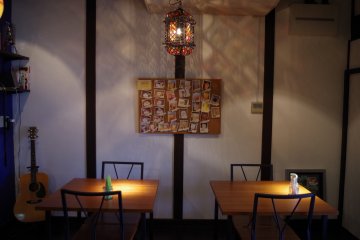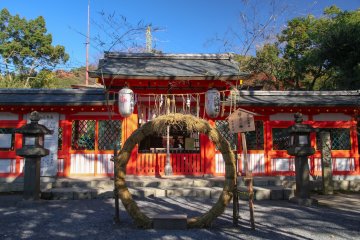

The Byodoin Temple in the city of Uji near Kyoto adorns the reverse of the Japanese 10 yen coin and is best known for its distinctive “phoenix hall”. The original building was built in 998 as a nobleman's villa and later by a member of the then Influential Fujiwara clans acquired and converted into a temple.
Over the centuries the temple complex has been expanded and expanded, among other things, by the phoenix hall, inside of which there is an Amida Buddha statue and which thus forms the heart of the temple complex. Even if its official name is Amida Hall because of this statue, it is mainly referred to as the Phoenix Hall because of the representations of the Chinese firebird on the roof.
The Byodo-in Temple has been a UNESCO World Heritage Site since 1994 and is a popular tourist destination because of its special architecture and the surrounding garden. Visitors can also admire the interior of the hall on a guided tour.
10-minute walk from JR Uji Station on the JR Nara Line 10-minute walk from Keihan Uji Station on the Keihan Railway Uji Line

[photo] 中村藤吉是宇治的名店,幾乎所有的旅遊書都會提到,同時也是許多遊客必定造訪的抹茶名店之一。 [photo] 從JR宇治站前,往正對面的街道走入,即可看到中村藤吉,是一間日式風格的建築。 [photo] [photo] 店內還有販售一些周邊商品,例如杯墊、桌墊等,都是布織品,本來想買一塊桌墊,帶回家當我桌上茶具的墊子,但看到價錢之後,幾經考慮,還是決定放棄了。價格實在太高,這樣一小塊布竟然要台幣六百多元,實在太貴了。 中村藤吉主要是以販售抹茶類的甜點冰品為主,不過也有些熟食可點。 生茶ゼリイ¥720 [photo] 用竹筒裝的生茶ゼリイ,其中有一大球抹茶冰淇淋、三顆白湯圓、抹茶凍以及紅豆。香甜紅豆搭上微苦的抹茶,味道中和,可惜紅豆有點少,讓人意猶未盡。冰淇淋 的抹茶味濃郁,不死甜,反而帶了點茶的苦味,白湯圓吃起來就與台灣的小白湯圓差不多,抹茶凍同樣也是帶著茶香以及些微苦味。這整碗冰品吃起來不會讓人感到 非常甜膩,而是抹茶的清爽。不過份量真是不少,吃完之後有點飽足感。 此外,中村藤吉也有外帶的商品販售,同樣是買伴手禮的好地方。本來想買抹茶巧克力,但包裝表示需冷藏,怕又會跟去年去首爾帶回的抹茶巧克力一樣融化,最後還是決定買個不會融化的糖果,有點可惜。 中村藤吉本店 地址:日本國京都府宇治市宇治壱番十番地 電話:0774-227800 網站:http://www.tokichi.jp/ Agoda推薦京都住宿 京都皇家飯店@三條/河原町#地鐵京都市役所前站 京都烏丸五条超级飯店@烏丸五條#地鐵五條站 Sakura Terrace@京都車站#地鐵九條站 京都蒙特娄飯店@烏丸#地鐵烏丸站 新阪急飯店@京都車站#JR京都站 京都格蘭比亞飯店@京都車站#JR京都站 卡莫加瓦堪飯店@三條/河原町#地鐵京都市役所前站 京都阿爾蒙特旅館@京都車站#JR京都站 京都新都飯店@京都車站#JR京都站 京都四條麥斯泰飯店@烏丸#地鐵烏丸站 京都八条大和魯內飯店@京都車站#JR京都站 京都京阪飯店@京都車站#JR京都站 阿蘭維特飯店@烏丸五條#地鐵五條站 晴鴨樓旅店@烏丸五條#地鐵五條站 東橫INN 京都五條烏丸@烏丸五條#地鐵五條站 京都大倉飯店@三條/河原町#地鐵京都市役所前站 首先小屋京都烏丸@四條/烏丸#地鐵四條站 京都威斯汀都飯店@東山/祗園#地鐵祗園四條站 京都大飯店@京都車站#JR京都站 延伸閱讀: [食記] 宇治 伊藤久右衛門 [食記] 京都 よーじやカフェ Yojiya cafe [食記] 京都 中村屋可樂餅 [食記] 京都 京蒸しまん本舖 [食記] 京都 龍安寺香葉茶 [食記] 京都 練薬膳点心 [食記] 京都 田中鶏卵 [食記] 京都 餅寅 光秀饅頭 [食記] 京都 まつばや手作抹茶泡芙 [食記] 京都 おはぎの丹波屋 [食記] 京都 梅山堂清水燒 [食記] 神戶 Juchheim 德式蛋糕 [食記] 神戶 神戶六甲牧場 [食記] 大阪 天保山名物 さとの花燒

【祢ざめ家】是小魚兒在找資料時無意間看到不少人分享鰻魚飯的店家~ 一直對鰻魚飯沒有太大興趣的大熊和小魚兒不斷地聽見身旁的朋友說日本的鰻魚飯有多美味~ 【祢ぎめ家】價位還算親民,於是將此店家納入口袋名單中,若有機會就來去嚐嚐~

Located in Uji, the city renowned for green tea, Ujigami shrine is Japan’s oldest existing shrine. Among the country’s thousands of shrines, Ujigami shrine was one of the first — allegedly built during the year 1060. Although the shrine is rather off the beaten track, its convenient location makes it easy to combine visits with nearby Byodo-in Temple and Uji-gawa Shrine. Ujigami-jinja’s grounds are quiet and serene, located away from the bustling tourist attractions in central Kyoto. It was originally built to honor Emperor Ojin and his sons, after one of the princes committed suicide in a selfless effort to solve the dispute over imperial succession. Now, Ujigami shrine also serves as the guardian shrine for Byodo-in Temple. Visitors to Ujigami-jinja will also notice the abundance of rabbit motifs. The puzzling presence of rabbits is related to a myth about a divine rabbit that guided the lost prince back to town. Since then, the rabbit has been honored in the form of figurines, omikuji and more in the city of Uji. The temple’s springwater is said to have special qualities, making it the best choice for use in traditional tea ceremonies — rated to be among the 'Seven best waters of Uji'. Its main Honden building is also believed to be the oldest remaining example of nagare-zukuri-style architecture. Being host to such historically significant sites, it is no wonder that Ujigami-jinja was designated a UNESCO World Heritage Site in 1994.

The Nintendo Museum in Uji City, Kyoto, offers a rare chance to explore the full legacy of one of Japan’s most influential entertainment companies. Whether you're a lifelong fan of Mario, Zelda, Pokémon, and other beloved Nintendo franchises or simply curious about how gaming has evolved over the years, this museum offers a hands-on look into the creative history behind it all. Housed in the former Nintendo Uji Ogura Plant, the museum has been thoughtfully renovated into a modern, visitor-friendly space. The interior has been redesigned for access and accessibility while much of the entire building's original character has been preserved. Inside, you’ll find a wide-ranging showcase of the entertainment Nintendo has created since its founding in September 1889—from traditional Hanafuda playing cards to the latest Nintendo Switch. Exhibits are arranged by era on the second floor of Exhibition Building 1, allowing visitors to follow Nintendo’s story from past to present. Across several themed zones, you can view side-by-side displays of early toys, classic handhelds, and home consoles that helped shape the gaming world. Iconic systems like the Famicom (NES), Game Boy, and Nintendo 64 are on display in excellent condition. Each exhibit is accompanied by easy-to-follow visuals in both English and Japanese, along with interactive features that let you explore Nintendo’s legacy at your own pace. Another highlight of the museum is the Unique Play Experiences area on the first floor of Exhibition Building 1. This zone features interactive exhibits that capture Nintendo’s signature blend of creativity and innovation—including games that use oversized controllers and play out on giant screens. Each visitor receives 10 digital coins upon entry, which can be used to access selected exhibits. Since each activity requires a different number of coins, you’ll need to choose carefully—adding a light strategic element to your visit, much like playing a Nintendo game itself. After exploring the interactive exhibits, visitors looking for a more hands-on, creative experience can join the craft workshop. Here, you’ll create your own Hanafuda playing cards. Once your set is complete, you’ll also learn the rules and have a chance to play the game. This experience requires a same-day reservation and an additional fee, so be sure to plan ahead if you’d like to take part. Ticket information A visit to the Nintendo Museum takes about 1.5 to 2 hours, and you’ll need to plan ahead as same-day admission isn’t available at the moment. Tickets are offered through a lottery system, and you can apply up to three months before your visit using a free Nintendo Account. If your entry gets selected, make sure to pay by the 7th of the following month using a credit card. You’ll get an email with the results, but you can also check the ticketing site. Further, your QR code ticket will be ready to download from 2pm the day before your visit. On the day itself, don’t forget to bring your QR code and a valid ID. If you’re not a Japanese national, your passport is required. Once your code is scanned and you pass through security, you’ll get your official play ticket. If you bought tickets for friends or family, you can assign them their own QR codes too, as long as they have Nintendo Accounts. The ticketing system is a bit of a process, but the visit offers a fun and nostalgic dive into Nintendo’s world—something many fans find well worth the effort.

Ōbaku-san Manpuku-ji is a temple located in Uji, Kyoto. It is the head temple of the Japanese Ōbaku Zen sect, named after Wanfu Temple in Fujian, China. The mountain is likewise named after Mount Huangbo, where the Chinese temple is situated. [Wikipedia]